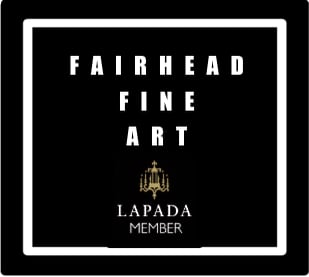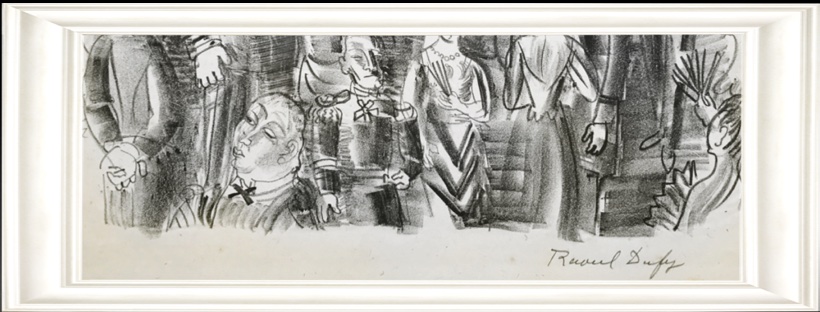THE PETIET STAMP - WHO WAS HENRI MARIE PETIET?
Henri Petiet was a key figure in 20th Century art market. He was born into a family renowned for over two centuries for its service to the French state in administration, military, politics and industry. His ancestor, Claude Petiet, Minister of War in the French Directory Government appointed the young General Bonaparte as Chief Commander of the army in Italy, leading the campaign there which earned the Petiet family a noble title.
Endowed with great intelligence and a prodigious memory, of a scientific mind-set and an appetite for collecting, Henri first became interested in trains, illustrated books, and classic veteran cars, but his primary passion was the art print.
In 1925 he became an art dealer, six months after meeting the famous art dealer Ambroise Vollard who had worked with the greatest painters from Cezanne to Van Gogh and who had organised exhibitions such as Picasso’s first one in 1901. Without doubt the high point of his life started with this meeting in 1924 which would prove to be decisive in Petiet's life.
Two years later, in 1927, he launched himself internationally, starting by developing the print market in the UK, working closely with several galleries the Independent Gallery, the Leicester Gallery, Ernest Brown and Phillips Ltd, P&D Colnaghi & Co and of course with Campbell Dodgson, curator of the Prints and Drawings Department at the British Museum who became a good friend.
And in the US Petiet was the man behind entire print departments of American Museums such as the Brooklyn Museum of Art, Museum of Fine Art Boston. He played a key role in enhancing the place of the print in major American collections, both public and private, thanks to the confidence and trust he gained from important curators, such as Carl O. Schniewind and Harold Joachim in Chicago, Agnès Mongan at the Fogg Museum, Elisabeth Mongan, Eleanore Sayre in Boston, Adelyn Breeskin in Baltimore, and dealers such as Georges Keller or collectors like Lessing J. Rosenwald. In New York he built an association with Kraushaar Galleries, the Weyhe Gallery and Kennedy & Co. Some years later, thanks to his friend Jean Goriany, his engravings were purchased by the Brooklyn Museum of Art, Boston Museum of Fine Arts, Art Institute of Chicago.
He very quickly sought to become the sole publisher of prints in order to control prices.
In 1933 he finally opened his own gallery at 8, rue de Tournon in Paris.
His greatest stroke of genius was in his purchasing of the Vollard Collection when Ambroise Vollard accidentally passed away in July of 1939, leaving behind no children or will. While the art world was in shock and wondering what would become of the treasure owned by this overlord of modern art, Henri Petiet moved fast and bought all of the prints from the Vollard collection including a monumental ensemble of prints, the ‘Vollard Suite’, Picasso’s masterpiece, a set of 100 plates etched and engraved between 1930 and 1937 on a variety of subjects, the artist’s studio, the rape, the Minotaur, and concluding with three portraits of Vollard which Petiet failed to obtain but would later get hold of; a dizzying number of 31,000 prints!
Only a few of the prints were signed. But in November of 1950, and after long negotiations, Picasso agreed to sign one set of the ‘Vollard Suite’. Petiet agreed to the demands and the fees of the highly sought-after Master, and he patiently waited through the delicate signing ceremony until the 9th of July 1969, since that date Picasso refused to sign any more sets of the Vollard Suite.
In 1977, three years before his death and still going strong at 83, Petiet purchased Odilon Redon’s extraordinary decorative panels, created by the artist for the dining room at the Chateau de Domecy.
Endowed with great intelligence and a prodigious memory, of a scientific mind-set and an appetite for collecting, Henri first became interested in trains, illustrated books, and classic veteran cars, but his primary passion was the art print.
In 1925 he became an art dealer, six months after meeting the famous art dealer Ambroise Vollard who had worked with the greatest painters from Cezanne to Van Gogh and who had organised exhibitions such as Picasso’s first one in 1901. Without doubt the high point of his life started with this meeting in 1924 which would prove to be decisive in Petiet's life.
Two years later, in 1927, he launched himself internationally, starting by developing the print market in the UK, working closely with several galleries the Independent Gallery, the Leicester Gallery, Ernest Brown and Phillips Ltd, P&D Colnaghi & Co and of course with Campbell Dodgson, curator of the Prints and Drawings Department at the British Museum who became a good friend.
And in the US Petiet was the man behind entire print departments of American Museums such as the Brooklyn Museum of Art, Museum of Fine Art Boston. He played a key role in enhancing the place of the print in major American collections, both public and private, thanks to the confidence and trust he gained from important curators, such as Carl O. Schniewind and Harold Joachim in Chicago, Agnès Mongan at the Fogg Museum, Elisabeth Mongan, Eleanore Sayre in Boston, Adelyn Breeskin in Baltimore, and dealers such as Georges Keller or collectors like Lessing J. Rosenwald. In New York he built an association with Kraushaar Galleries, the Weyhe Gallery and Kennedy & Co. Some years later, thanks to his friend Jean Goriany, his engravings were purchased by the Brooklyn Museum of Art, Boston Museum of Fine Arts, Art Institute of Chicago.
He very quickly sought to become the sole publisher of prints in order to control prices.
In 1933 he finally opened his own gallery at 8, rue de Tournon in Paris.
His greatest stroke of genius was in his purchasing of the Vollard Collection when Ambroise Vollard accidentally passed away in July of 1939, leaving behind no children or will. While the art world was in shock and wondering what would become of the treasure owned by this overlord of modern art, Henri Petiet moved fast and bought all of the prints from the Vollard collection including a monumental ensemble of prints, the ‘Vollard Suite’, Picasso’s masterpiece, a set of 100 plates etched and engraved between 1930 and 1937 on a variety of subjects, the artist’s studio, the rape, the Minotaur, and concluding with three portraits of Vollard which Petiet failed to obtain but would later get hold of; a dizzying number of 31,000 prints!
Only a few of the prints were signed. But in November of 1950, and after long negotiations, Picasso agreed to sign one set of the ‘Vollard Suite’. Petiet agreed to the demands and the fees of the highly sought-after Master, and he patiently waited through the delicate signing ceremony until the 9th of July 1969, since that date Picasso refused to sign any more sets of the Vollard Suite.
In 1977, three years before his death and still going strong at 83, Petiet purchased Odilon Redon’s extraordinary decorative panels, created by the artist for the dining room at the Chateau de Domecy.
Graphics that come from his collection bear the Petiet (H M P) stamp. Featured image from the Petiet collection in stock: https://www.fairheadfineart.com/store/product/raoul-dufy-le-bal-chez-lamiral

